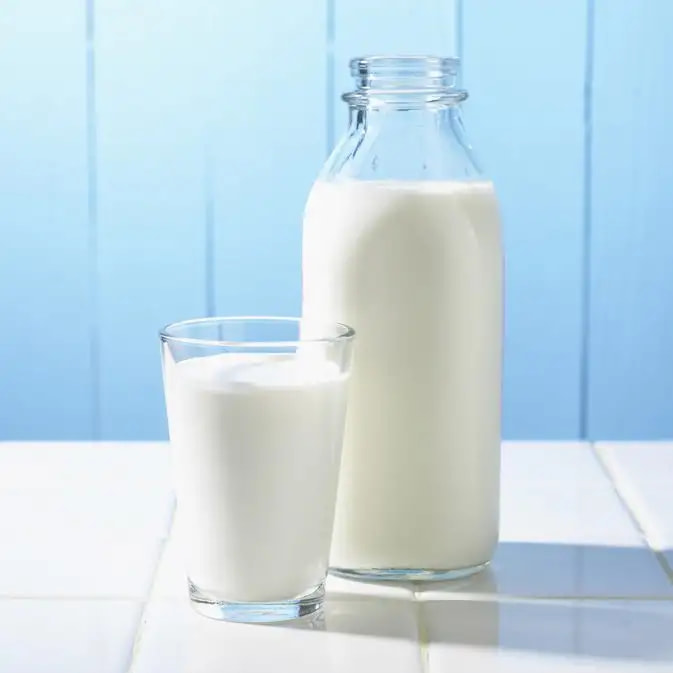Home

Baby Care

When is the best time to give your child cow's milk and how to make the switch easier?
In this Article

Baby Care
When is the best time to give your child cow's milk and how to make the switch easier?
Updated on 26 February 2023



Medically Reviewed by
Kusum Sabharwal
Obstetrician & Gynecologist - MBBS| DGO
View Profile

When can you give cow's milk to your baby?
One of the best things you can do for your baby is to start the inclusion of healthy and nutrient rich food and to begin with is milk. However, you need to wait till your baby turns one. You should start with full cream milk and not skimmed or low-fat milk, as the included fat is healthy for the baby’s brain.
Cow's milk is a rich source of nutrients and minerals, making it a popular choice for parents to introduce to their baby's diet. However, it is essential to introduce cow's milk at the right age and in the right quantity to avoid any adverse effects. In this article, we will discuss when to give cow's milk to your baby and how to make the transition from breast milk or formula easier.
When to introduce cow's milk to your baby?
According to the American Academy of Pediatrics (AAP), cow's milk can be introduced to a baby's diet after the age of 1 year. Before that, it is recommended that infants should only be fed breast milk or formula, as these provide the necessary nutrients for their growth and development.
Introducing cow's milk too early can lead to various health problems such as anemia, allergies, and even kidney damage. Therefore, it is essential to wait until your baby is at least one year old before offering cow's milk.
Why wait till your baby turns one?
You might be excited to start on milk a little sooner, but breast milk contains many nutrients, most of which are lacking in cow’s milk or are not available in enough quantity.
Though by the time your baby turns one, they are able to compensate on the lost food items with a diet which includes fruits, vegetables and whole grains.
Babies who begin with cow’s milk before the age of 1 are likely to develop gastrointestinal distress or certain other deficiencies. As there is too much protein in cow’s milk for the baby’s kidneys to handle, switching to cow milk can affect the body systems.
Side effects you may notice
When you switch to cow’s milk lactose sensitivity may develop soon after, in that case it is advised to be on the lookout for any of the following symptoms:
-
Excess gas
-
Diarrhoea
-
Skin rashes
-
Change in baby’s poop in terms of composition, colour or texture
How to make the switch easier
After months of feeding on breast milk, your baby may not like the flavour or consistency of cow’s milk. Here’s how you can make the transition smoother.
Start with small quantities: Begin by introducing small amounts of cow's milk to your baby's diet. You can mix it with their usual milk to make the transition easier. Gradually increase the amount of cow's milk in the mix over a week or two until your baby is comfortable with drinking cow's milk alone. You can give milk in a bottle to your baby.
Offer it in a cup: Encourage your baby to drink cow's milk from a cup instead of a bottle. This will help them associate cow's milk with a new mode of drinking and make the transition easier.
Serve it warm: The breast milk is at body temperature whereas the milk you may be holding may vary in terms of hot or cold. So, it is necessary that you prepare the milk at body temperature to avoid rejection by the baby in the first instance.
Mix and offer: Offer your baby half of the breast milk and half of the cow’s milk to let them develop the taste. After a few days, you can lower the ratio of breast milk and increase the amount of cow’s milk.
Add extra taste: To make drinking cow’s milk a delight add a bit of flavour so that your baby can relish it and does not try to avoid it.
Be patient: It may take some time for your baby to get used to the taste and texture of cow's milk. Be patient and persistent, and keep offering cow's milk to your baby.
Conclusion:
In conclusion, cow's milk can be introduced to your baby's diet after the age of 1 year. It is essential to introduce it gradually and in small quantities to make the transition easier for your baby. You can add flavors to make cow's milk more palatable, but avoid adding sugar or any other sweeteners. With patience and persistence, your baby will eventually get used to drinking cow's milk, and it will become a regular part of their diet.





Medically Reviewed by
Kusum Sabharwal
Obstetrician & Gynecologist - MBBS| DGO
View Profile


Written by
Mylo Editor
Official account of Mylo Editor
Read MoreGet baby's diet chart, and growth tips

Related Articles
RECENTLY PUBLISHED ARTICLES
our most recent articles

Labour & Delivery
How to Handle Giving Birth to a Baby Alone?

Getting Pregnant
Can You Get Pregnant During Your Period?

Pregnancy
When to Make an Emergency Doctor Visit During Pregnancy?

General Toddler
How to Help Your Toddler Overcome their Shyness?

Announcements & Celebrations
Piercing Your Baby's Ears: Risks & Precautions

Third Trimester
Which Food items to Include & Avoid During Third Trimester of Pregnancy for optimum nutrition?
- Breech Baby: Causes, Risks, Flipping & Delivery
- Everything You Need to Know About the Different Stages of Labour
- What are the Symptoms of Vitamin D Deficiency in Children?
- Top 5 Effective Ways to Prevent Diabetes in Children
- Why and When Is the Tetanus Toxoid (TT) Vaccine Given During Pregnancy?
- How to Guide Your Child to Make Healthy Food Choices and Get the Required Nutrition?
- How Can You Manage Asthma During Pregnancy?
- Water Breaking Early: Signs, Causes & Next Steps
- Foods to eat for healthy fetal brain development
- How touch can shape babies’ brain development
- In What Situations Can a Doctor Recommend You to Take Bed Rest During Pregnancy?
- How to Hold a Newborn Baby
- Why do you need to burp your baby and what are the best positions to burp your baby?
- Carpal Tunnel Syndrome or CTS During Pregnancy : Symptoms, Causes & Treatment


AWARDS AND RECOGNITION

Mylo wins Forbes D2C Disruptor award

Mylo wins The Economic Times Promising Brands 2022
AS SEEN IN
















- Mylo Care: Effective and science-backed personal care and wellness solutions for a joyful you.
- Mylo Baby: Science-backed, gentle and effective personal care & hygiene range for your little one.
- Mylo Community: Trusted and empathetic community of 10mn+ parents and experts.
Product Categories
baby carrier | baby soap | baby wipes | stretch marks cream | baby cream | baby shampoo | baby massage oil | baby hair oil | stretch marks oil | baby body wash | baby powder | baby lotion | diaper rash cream | newborn diapers | teether | baby kajal | baby diapers | cloth diapers |








